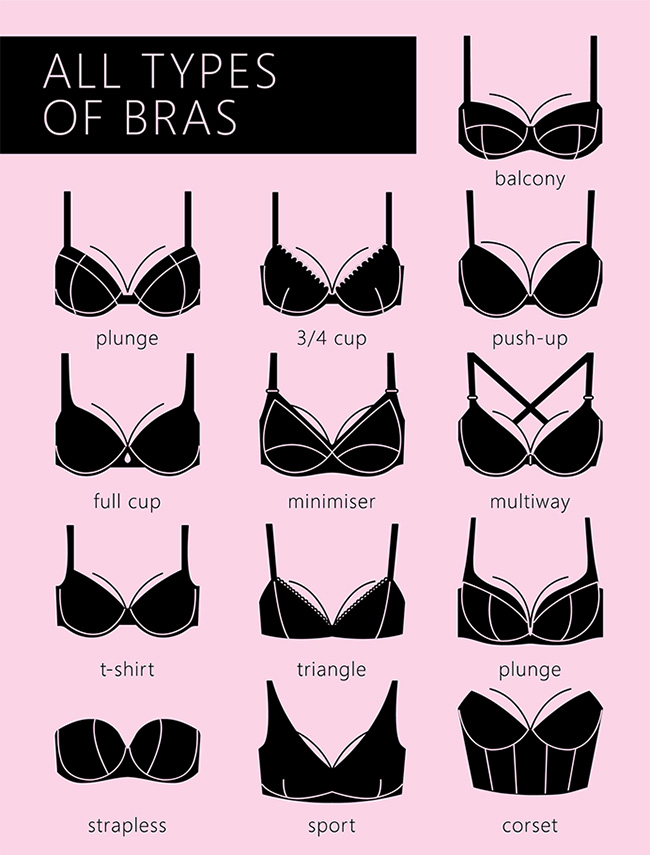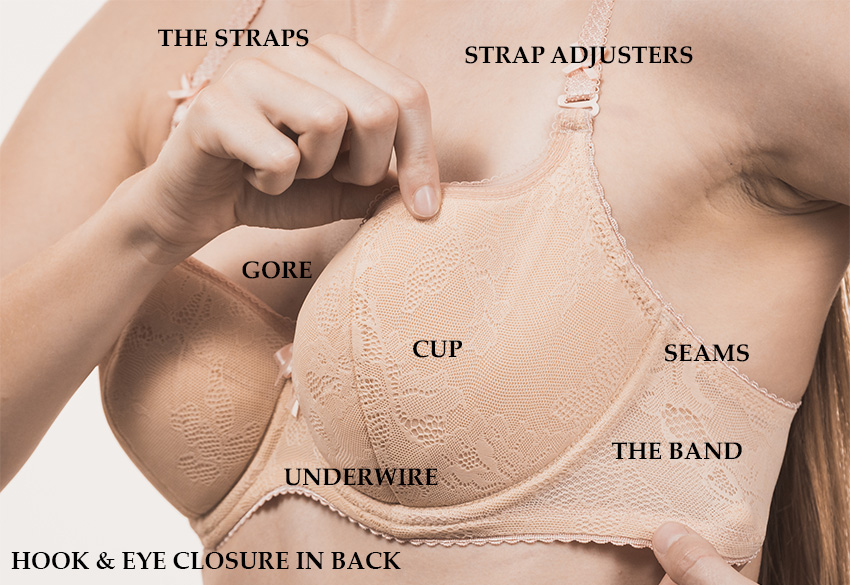A common question we get in our store is about what the purpose of each functioning part of a bra is supposed accomplish. Since we love informing and educating our customers on bras and how they are designed to work with our bodies, let's begin. I hope this information will help.
 Different Bra Types with Various Components
Different Bra Types with Various Components
THE CUPS: Bra cups can be made of different fabrics. They may offer full coverage, half-coverage, plunging coverage, etc. They've basically made a bra for any type of clothing you wear. Your cups should surround each breast and lie flat on your skin. The cups should never dig into your breast tissue across the top, nor should they gape or wrinkle to create a hollow space. These are signs that your bra is too small or too big. We're looking for that optimal flush finish on a bra with that perfect fit. Where your cups start and end should be invisible under your clothing. As the band size increases or decreases, the cup adjusts accordingly. A C cup can be bigger than D or DD cup - it just depends on what the band size is.
 Parts that Make Up a Bra
Parts that Make Up a Bra
HOOK & EYE CLOSURE: The hook and eye closure is usually in the back of your bra, although, it can be in the front if you have a front closure bra. If it is in the back, it should rest slightly lower than the shoulder blades in the center of your back. The hooks secure the band and your bra in place. If you choose a bra that fits snugly on the tightest set of hooks, the band may become too loose in a matter of weeks or a few months.
THE UNDERWIRE: A properly fitted bra should never have you lifting or adjusting. If your bra is too big or too small, you're going to be feel uncomfortable. Underwire bras should fully encompass your breast and sit flat against your rib cage just beneath where the breast tissue ends. If your bra does not lie flat against your rib cage, it's the wrong size. The underwire is there to shape and contour your breasts to produce a rounder, lifted shape. Everyone has a preference, some women just can't wear an underwire. Wire free bras are generally not as supportive, separating, or shaping as underwire styles, but some women prefer comfort over anything else.
THE GORE: The gore is the space between the breasts. It connects the cups and also houses the end of the wires. The gore sometimes vary in height - a full support bra will have a higher gore than a plunge bra will. In each case, it is important that this space lies flat between the breasts. The gore's purpose is to help separate the breasts and help create that rounded look you desire.
THE BAND: The band is probably the most important part of the entire bra. Think of the band as your bra's anchor. A band that is too big will result in a bra that won't stay put. A correctly sized bra band will feel tight at first, but it should not be uncomfortable. The band should be level with the front of the bra and parallel to the ground. There should be room to pull the band away from your body so a fist fits between your back and the bra, but you should not be able to pull it away any farther. A snug bra band provides up to 80% of the support for your breasts.
STRAPS & STRAP ADJUSTERS: The most common misconception about bra straps is that they provide your support. As we mentioned earlier, 80% of the bra’s support comes from the band. Straps shouldn't be digging into your skin, nor should they be falling down your shoulders. Adjust the slides on your straps so you can comfortable stack two fingers between your straps and your fingers. If your bra straps are still falling down, try a bra with closer set straps or convert to a racer back.
SEAMS: Seams are on bras in every size but become a more common feature as the overall size of a bra increases. The reason is that seams offer support and shaping that an underwire cannot. Seams split the cups into separate parts and reinforce the cup fabric and shape the breast into an ideal round and lifted shape. The more seams a bra has, the more supportive it will be. Seams that run vertical or diagonal to your body center and lift the breasts while the seams that run on a horizontal curve produce their shape. A one-piece molded cup just doesn't have the ability to provide the same support as a seamed bra. A common complaint is that the bra no longer becomes invisible under clothing - in most bras seams will relax and provide a smooth finish under clothing. It just takes time and you just need to break them in.